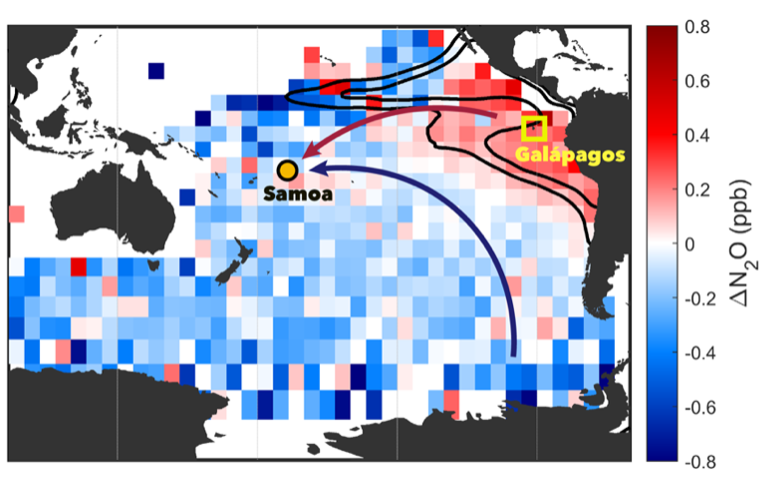The lab is executing an exciting new vision, combining in-situ atmospheric chemistry sampling with back trajectory / inversion modeling to quantify nitrous oxide emissions from the ocean. We are about to deploy a cavity ring-down spectrometer to continuously measure nitrous oxide at the Galápagos Science Center. Lasers. Giant tortoises. Laughing gas. Penguins. Need we say more? Yes, probably! Discover details (and data!) at our specially maintained website, gems.mit.edu.

Nitrous oxide (N2O) sources are largely microbial: N2O is a product of the metabolisms specifically occurring in low-oxygen marine ecosystems. Atmospheric N2O concentrations are rising, attributed mostly to artificial fertilizer application, but the undetermined secondary effects of global change from warming oceans can increase atmospheric N2O many-fold. Yet the ocean’s role in N2O has been routinely minimized in the gold standard of climate change estimates, the Intergovernmental Panel on Climate Change assessments. The ocean source exhibits a high degree of spatial structure, with N2O production being likely concentrated in the confines of the oxygen minimum zones (OMZs) of the eastern tropical Pacific and Arabian Sea due to the same physical processes that make them likely hotspots for greenhouse gases writ large: surface upwelling. This localization to remote areas impedes the direct data acquisition required to understand the system’s dynamics, yet correct attribution of N2O sources is key to interpreting observations, establishing mitigation policies, and predicting future feedbacks on climate.
N2O is a significant gas for current and future climate change. Both a potent greenhouse gas and substantial agent of stratospheric ozone destruction, it serves a dual role in regulating climate. Its production is substantially amplified in low oxygen systems like the marine oxygen minimum zones of the eastern tropical Pacific Ocean. However, precious few direct measurements exist in these areas, severely limiting our ability to understand the role of natural (and variable) production of this gas for Earth’s climate. We aim to conclusively identify the role of marine N2O production by establishing an atmospheric chemistry monitoring site in the critical zone of the eastern Pacific to identify hotspots and mechanisms. The Galápagos station will permit great strides in short time for understanding the ocean’s role in the greenhouse budget. Excitingly, with this system, we will be able to diagnose the ocean’s characteristics through its interaction with the atmosphere over the next year, and launch a long-term monitoring site in a critically under-sampled yet imperative site for understanding Earth’s climate today and into the future.